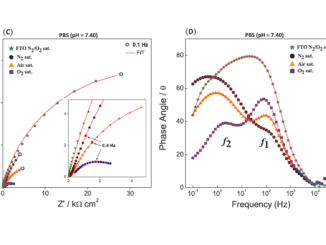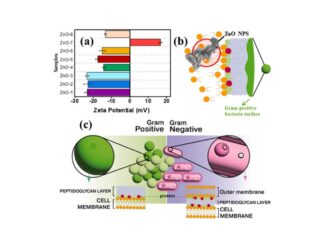
Synthesis and characterization of Restricted Access Magnetic Nanotubes (M-RACNTs) for the extraction of secondary metabolites from Lasiodiplodia sp. fermentation broth
Abstract: This work proposed the synthesis and the characterization of Restricted Access Magnetic Nanotubes (M-RACNTs) to be used as sorbent in the magnetic dispersive solid-phase extraction (MDSPE) of organic compounds from the fermentation broth of the endophyte Lasiodiplodia sp. Synthesis was performed by functionalizing commercial multiple-walled carbon nanotubes with magnetic nanoparticles (M-CNTs) and by coating the M-CNTs with a layer of bovine serum albumin. The materials were characterized by infrared spectroscopy with Fourier Transform, thermogravimetry, zeta potential, and scanning electron microscopy. Different crude extracts were obtained, depending on the sample pH and the elution solvent tested. Chloroform and ethyl acetate extracts showed activity against a Gram-positive pathogen (Staphylococcus aureus). The crude extract’s constitution was investigated. By GC/MS analysis were found hydrocarbons, aldehydes, alcohols, among others, while by LC-MS/MS analysis were found flavonoids, macrocyclic lactones, oleic acids, jasmonic acid derivatives and amino acids. A multivariate optimization, through fractional factorial planning, for four independent variables, was performed for a hydrocarbon (hexadecane) and one possible jasmonic acid derivative, both with antimicrobial activity related in the literature. The results showed that it was possible to obtain crude extracts with high concentrations of these analytes in a single extraction procedure. The increase in the analytical signal was 3.7 times for hexadecane and 1.4 times for the possible jasmonic acid derivative. The M-RACNTs also demonstrated their ability to prevent the adsorption of macromolecules, such as lysozyme, which was confirmed through SDS-PAGE analysis.
Author(s): Cristiane dos R. Feliciano, Heloisa Sales de Souza, Vinicius Câmara Costa, Omar Cabezas Gómez, Jaine Honorata Hortolan Luiz, Luiz Fernando Gorup, Mariane Gonçalves Santos
Diamond and Related Materials
Published: February 2024, Volume 142, 110763
DOI: https://doi.org/10.1016/j.diamond.2023.110763
CDMF
The CDMF, hosted at the Federal University of São Carlos (UFSCar), is one of the Research, Innovation and Dissemination Centers (RIDC) supported by the São Paulo State Research Support Foundation (Fapesp), and also receives investment from the National Council Scientific and Technological Development (CNPq), from the National Institute of Science and Technology of Materials in Nanotechnology (INCTMN).




